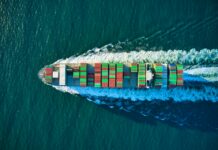
Sea-Intelligence noted in its latest report that when annualised against 2019, volume growth on the North America West Coast (NAWC) stagnated during the first two months of the traditional peak season of the third quarter, while outright contracting in September 2022.
“This trend continued into October and November,” pointed out Alan Murphy, CEO of Sea-Intelligence.

The above figure shows the laden import volumes on both a year-on-year basis, as well as an annualised basis compared to 2019.
Sea-Intelligence’s analysts noted that “If we look across the latter metric [annualised basis compared to 2019], the growth rate has been on a downwards trend, from a peak of 14.2% in March 2022 to 4.4% in June, and then briefly dropping below 0% in July to -0.7%, before dropping again in September to -3.3%.”
According to the report, in October and November, the growth rate continued to decline, dropping to -4.1% in November.
Sea-Intelligence noted that like total handling volumes, laden inbound volumes are now also firmly negative. “On a Y/Y basis, laden imports have been negative for most of the period since mid-2021, and have dropped below -20% in October and November of 2022,” said Murphy.
Furthermore, the decreasing trend in laden imports hints at a continued demand decrease into 2023, with additional contractions in demand across Chinese New Year highly likely. “With capacity levels already high, and additional capacity being released due to the reduction in bottlenecks, this drop in demand puts pressure on the shipping lines to blank additional capacity during Chinese New Year to stop a potential acceleration in freight rate decline,” commented Murphy.
CEO of Sea-Intelligence concluded that “a slight positive, however, is the increase in the laden-export-to-empty-export ratio (improvement towards laden exports). While the ratio is still below 1 – favouring empty exports – it increased from 0.5 to 0.7 in November. The improvement is not because of a sudden burst of laden exports, which are still contracting within -8% and -11%, but a slowdown in empty exports, the growth of which has now nearly stagnated.”







